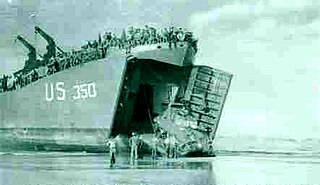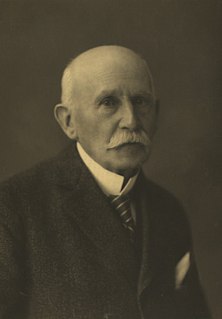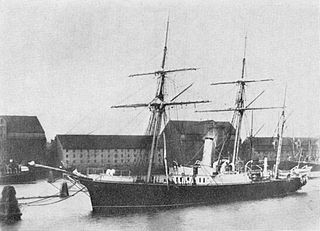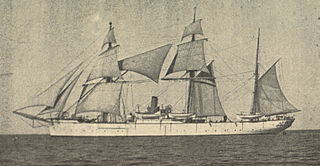Related Research Articles

HDMS Sælen (S323) is one of the three Tumleren-class small coastal submarines of the Royal Danish Navy.
At least three ships of the Royal Danish Navy have borne the name HDMS Triton:

ORP Dzik (Boar) was a U-class submarine built by Vickers-Armstrong at Barrow-in-Furness. She was laid down on 30 December 1941 as P-52 for the Royal Navy, but was transferred to the Polish Navy during construction. Launched on November 11, 1942, ORP Dzik was commissioned into the Polish Navy on December 12, 1942. Her name meant "Wild Boar" in Polish.

USS LST-350 was one of 390 tank landing ships (LSTs) built for the United States Navy during World War II.

HDMS Peder Skram was a Peder Skram-class frigate in the Royal Danish Navy which was in use until 1990. It is now docked at Holmen in Copenhagen where it serves as a privately operated museum ship along with the ships of the Royal Danish Naval Museum. The ship is named after Peder Skram, a 16th-century Danish admiral.
Five ships of the Danish Royal Navy have borne the name HDMS Springeren:
Three ships of the Royal Danish Navy have borne the name HDMS Lougen. The name "Lougen" is derived from the river Laagen in Norway.
Four ships of the Danish Royal Navy have borne the name HDMS Niels Juel:

Carl Frederik Wandel was a Danish naval officer and polar explorer. He was largely involved in hydrographic work.
The following ships of the Royal Danish Navy have borne the name HDMS Diana:

HDMS Havfruen was a frigate of the Royal Danish Navy.
The following ships of the Royal Danish Navy have borne the name HDMS Bellona:
The following ships of the Royal Danish Navy have borne the name HDMS Flora:
The following ships of the Royal Danish Navy have borne the name HDMS Lossen:
At least three ships of the Royal Danish Navy have borne the name HDMS Galathea:

HDMS Hauch was a Danish gunboat, launched in 1862 and under command the following year. It was named after the naval officer Jens Erik Hauch, who died during the Battle of Copenhagen, while bravely defending the decommissioned frigate Kronborg against three Royal Navy ships of the line. Hauch can be viewed as a scaled-down version of the preceding six gunboats of the Thura class. Hauch was built entirely in iron and the smaller size meant that it could only accommodate a single cannon. The 30 lb smoothbore cannon was not very accurate and was replaced by a smaller, but rifled 18 lb cannon in 1864. Towards the end of her career the armament consisted of two small smoothbore cannons (falconets), used for warning shots during fisheries inspection duties. The steam engine was reused from the scrapped gunboat Støren. This engine lasted until 1886, when it was replaced by a new Burmeister & Wain 200 HP steam engine.
A number of ships of the Royal Danish Navy have carried the name Elefanten, or Elephanten. The modern translation of the English word "Elephant" in Danish-English dictionaries is "Elefant". The suffix -en is the definite article in Danish.
HDMS Elephanten (1773), ship of the line was an 18th-century ship-of-the-line in the Dano-Norwegian navy, built at Nyholm in Copenhagen to a design by the Frenchman Laurent Barbé.

HDMS Fylla was a Danish gunboat, launched in 1862. Fylla was built entirely in wood, rigged as a topsail schooner and equipped with a steam-driven propeller. The propeller could be raised up into a well when under sail. Original armament was turning cannons placed in the midline of the ship, but later replaced by smaller cannons on each side of the ship.

HDMS Ingolf was a Danish schooner-rigged steam gunboat build in iron and launched in 1876. Ingolf marks a transition between the traditional gunships with muzzle-loading cannons placed along the sides of the ship and modern breechloading and turning guns placed in the centerline of the ship. The guns on Ingolf were breechloading guns from Krupp in Germany. The steam engine was British and could deliver 650 HP. The propeller could be hoisted up into a well on the underside of the ship, so as not to slow down the ship when she went for sails. Ingolf undertook a large number of voyages, often in the North Atlantic in summer and the Danish West Indies in winter. From 1897 Ingolf also served as training ship for non-commissioned officers and cadets. During World War I Ingolf was part of the Danish alerted fleet. The last voyage as a training ship was in 1922 and went to the Mediterranean. Decommissioned in 1926 and sold for scrap.
References
- ↑ Balsved, Johnny E. (11 March 2006). "Ingolf (1934-1943), Inspection ship". Danish Naval History. Retrieved 25 November 2019.
- ↑ "F 350 - HDMS Ingolf". Seaforces.org. Retrieved 25 November 2019.
| This article includes a list of ships with the same or similar names. If an internal link for a specific ship led you here, you may wish to change the link to point directly to the intended ship article, if one exists. |